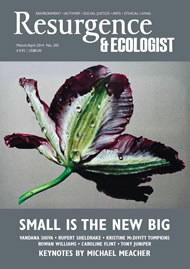“In wildness”, wrote Henry David Thoreau famously, “is the preservation of the world.” Today, with wild areas shrinking before the human machine, and with technology corralling our ways of seeing and being as never before, we might usefully adapt his words. In wildness, today, is the preservation of our souls.
Ever since there have been humans, the spiritual and practical functions of great wild areas, in taking us out of ourselves and bringing us into contact with forms of life that may not share our concerns, have long been understood. More recently, as science has advanced, the vital importance of untouched wild places has become clearer too. In a world of extinctions and climate change, there has never been a greater need to ensure that wild areas stay that way.
Seen in this context, the work of conservationists like Kris Tompkins assumes a great importance. Today, setting aside wild places and keeping them that way is not simply a pleasing thing to do. It is not simply the creation of breathing spaces for tourists or the creation of a living museum, but an ecological imperative. Without it, much of Nature as we know it may simply slide away, and our civilisation may slide with it.
For all of these reasons, this is a book that lifts the heart. A huge, glossy, 250-page hardback, it documents the creation of Monte León National Park in Argentinian Patagonia. Tompkins, former CEO of the Patagonia clothing company, walked away from a successful corporate career to dedicate the rest of her life, and her fortune, to projects like this. She founded a land trust, Conservacion Patagonica, dedicated to creating national parks, because, as she explains in the book’s introduction, “only a small percentage of Patagonia has been formally conserved,” despite it containing a huge variety of important, intact ecosystems.
Tompkins initiated the foundation of this national park more than a decade ago, and has seen it become a fully formed project, now owned and controlled by the Argentine National Parks Authority and protected in perpetuity. This book is a record of the project, with written contributions from many of the people involved, including Tompkins. But though the words are interesting, the real heart of the book is the photographs.
I have rarely seen a book as beautiful as this. Almost every image is breathtaking. Photographer Antonio Vizcaíno has walked much of the huge park, recording the moods of its skies and oceans, the patterns of its rocks, the habits of its colonies of penguins and walruses. His photographs are technically brilliant and beautifully composed. But it is the subject matter that makes them what they are, for this book is a record – and a reminder – of the incredible beauty of the natural world. In an age when many of us do not experience this beauty at all, and in an age where even green campaigners often use the language of science more than the language of beauty, it is a reminder that we need.
With this in mind, I would recommend that you get a copy of this book and keep it in your place of work, or in your home. Keep it somewhere you can access it when you feel burdened by the strains of everyday life; when you feel things getting on top of you, take it out, open it, turn the pages slowly and just drink in the images. Wonder at the huge sandstone cliffs dotted with thousands of Magellanic penguins; take in the complex swirls and deep colours of sun on orange stone; gaze at the huge sky reflected in the huge sea until you see nothing but the patterns; let the scale, the openness, the huge beauty of it sink into you.
I guarantee that what you see in this book will lift your spirits, as will knowing that this place exists, protected in all its wonder, for future generations to know.







